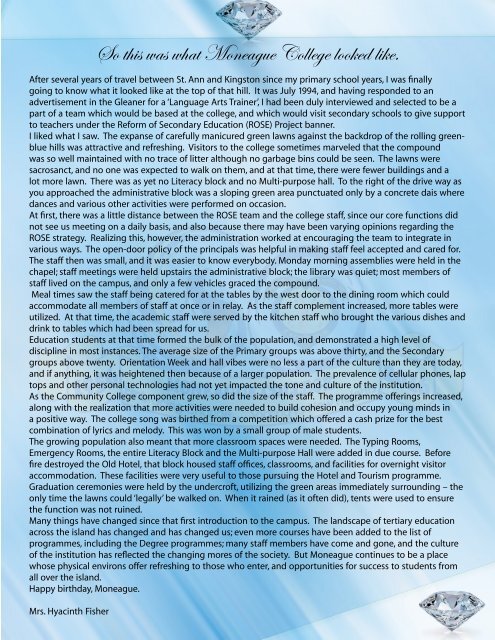Moneague College Magazine
Moneague College is a Tertiary Multidisciplinary institution that is centrally located in a small rural village in Saint Ann, a parish famous for its salubrious climate and its subterranean lake. The college has over the years evolved like a phoenix providing quality education and professional development to students both locally and internationally.
Moneague College is a Tertiary Multidisciplinary institution that is centrally located in a small rural village in Saint Ann, a parish famous for its salubrious climate and its subterranean lake. The college has over the years evolved like a phoenix providing quality education and professional development to students both locally and internationally.
Create successful ePaper yourself
Turn your PDF publications into a flip-book with our unique Google optimized e-Paper software.
So this was what <strong>Moneague</strong> <strong>College</strong> looked like.<br />
After several years of travel between St. Ann and Kingston since my primary school years, I was finally<br />
going to know what it looked like at the top of that hill. It was July 1994, and having responded to an<br />
advertisement in the Gleaner for a ‘Language Arts Trainer’, I had been duly interviewed and selected to be a<br />
part of a team which would be based at the college, and which would visit secondary schools to give support<br />
to teachers under the Reform of Secondary Education (ROSE) Project banner.<br />
I liked what I saw. The expanse of carefully manicured green lawns against the backdrop of the rolling greenblue<br />
hills was attractive and refreshing. Visitors to the college sometimes marveled that the compound<br />
was so well maintained with no trace of litter although no garbage bins could be seen. The lawns were<br />
sacrosanct, and no one was expected to walk on them, and at that time, there were fewer buildings and a<br />
lot more lawn. There was as yet no Literacy block and no Multi-purpose hall. To the right of the drive way as<br />
you approached the administrative block was a sloping green area punctuated only by a concrete dais where<br />
dances and various other activities were performed on occasion.<br />
At first, there was a little distance between the ROSE team and the college staff, since our core functions did<br />
not see us meeting on a daily basis, and also because there may have been varying opinions regarding the<br />
ROSE strategy. Realizing this, however, the administration worked at encouraging the team to integrate in<br />
various ways. The open-door policy of the principals was helpful in making staff feel accepted and cared for.<br />
The staff then was small, and it was easier to know everybody. Monday morning assemblies were held in the<br />
chapel; staff meetings were held upstairs the administrative block; the library was quiet; most members of<br />
staff lived on the campus, and only a few vehicles graced the compound.<br />
Meal times saw the staff being catered for at the tables by the west door to the dining room which could<br />
accommodate all members of staff at once or in relay. As the staff complement increased, more tables were<br />
utilized. At that time, the academic staff were served by the kitchen staff who brought the various dishes and<br />
drink to tables which had been spread for us.<br />
Education students at that time formed the bulk of the population, and demonstrated a high level of<br />
discipline in most instances. The average size of the Primary groups was above thirty, and the Secondary<br />
groups above twenty. Orientation Week and hall vibes were no less a part of the culture than they are today,<br />
and if anything, it was heightened then because of a larger population. The prevalence of cellular phones, lap<br />
tops and other personal technologies had not yet impacted the tone and culture of the institution.<br />
As the Community <strong>College</strong> component grew, so did the size of the staff. The programme offerings increased,<br />
along with the realization that more activities were needed to build cohesion and occupy young minds in<br />
a positive way. The college song was birthed from a competition which offered a cash prize for the best<br />
combination of lyrics and melody. This was won by a small group of male students.<br />
The growing population also meant that more classroom spaces were needed. The Typing Rooms,<br />
Emergency Rooms, the entire Literacy Block and the Multi-purpose Hall were added in due course. Before<br />
fire destroyed the Old Hotel, that block housed staff offices, classrooms, and facilities for overnight visitor<br />
accommodation. These facilities were very useful to those pursuing the Hotel and Tourism programme.<br />
Graduation ceremonies were held by the undercroft, utilizing the green areas immediately surrounding – the<br />
only time the lawns could ‘legally’ be walked on. When it rained (as it often did), tents were used to ensure<br />
the function was not ruined.<br />
Many things have changed since that first introduction to the campus. The landscape of tertiary education<br />
across the island has changed and has changed us; even more courses have been added to the list of<br />
programmes, including the Degree programmes; many staff members have come and gone, and the culture<br />
of the institution has reflected the changing mores of the society. But <strong>Moneague</strong> continues to be a place<br />
whose physical environs offer refreshing to those who enter, and opportunities for success to students from<br />
all over the island.<br />
Happy birthday, <strong>Moneague</strong>.<br />
Mrs. Hyacinth Fisher


